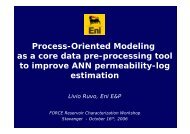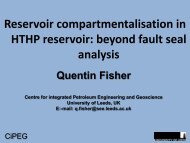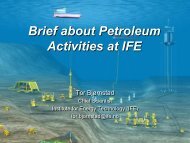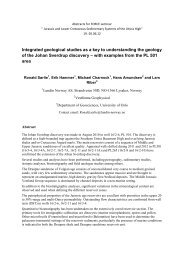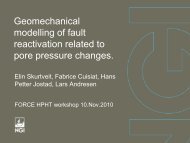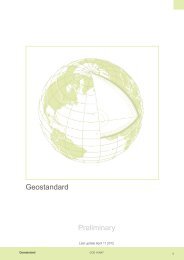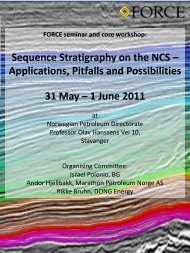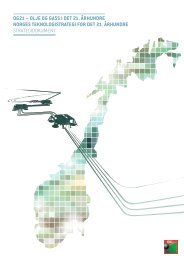analysis of long offset sub-basalt data using model-based ... - Force
analysis of long offset sub-basalt data using model-based ... - Force
analysis of long offset sub-basalt data using model-based ... - Force
Create successful ePaper yourself
Turn your PDF publications into a flip-book with our unique Google optimized e-Paper software.
emoval several stages <strong>of</strong> interpolation has to be carried out. This is both costly and complicatedbecause <strong>of</strong> streamer feathering. The <strong>long</strong>est <strong>of</strong>fsets contains reflections from <strong>sub</strong>-<strong>basalt</strong> eventstraveling through the high velocity <strong>basalt</strong> layer and comes in earlier than the overburdenreflections. However, the void area in the super shot gather <strong>of</strong> the two-boat geometrycomplicates the <strong>analysis</strong> <strong>of</strong> the early arrivals, since reflections cannot be mapped to normalincident a<strong>long</strong> a continous <strong>of</strong>fset range.Model-<strong>based</strong> processingThe measured reflection response from the <strong>sub</strong>-<strong>basalt</strong> events are complicated by strong multipleenergy, refractions and mode conversions. The velocity <strong>model</strong> built as part <strong>of</strong> the <strong>model</strong>-<strong>based</strong>processing, help to understand the nature <strong>of</strong> the <strong>sub</strong>-<strong>basalt</strong> reflections. Rays traced in the <strong>model</strong>are overlayed the pre-stack seismic and used to identify the observed response. Travel timecurves picked on pre-stack <strong>data</strong> might be depth migrated assuming a given mode (pp, pssp, etc).This procedure gives an improved understanding <strong>of</strong> the sensitivity and the non-uniqueness <strong>of</strong> theinversion problem.Both the moveout and the sorting are predicted by the <strong>model</strong> and is used in the <strong>model</strong>-<strong>based</strong>stacking. The early arrival reflection <strong>data</strong> are mapped <strong>model</strong> consistent to normal incident <strong>using</strong>this approach (Figure 1). Despite the lower frequencies obtained, mainly due to NMO stretchingand attenuation loss, sedimentary reflection events can be observed (Figure 2). Since theseevents are not influenced by the strong multiple energy, valuable information about the <strong>sub</strong><strong>basalt</strong>sedimentary reflections can be extracted. Angle band stacks <strong>of</strong> early arrivals have a goodpotential for mapping faults below the <strong>basalt</strong> (Figure 2). The velocity <strong>model</strong> is also used as inputto pre-stack depth migration (PSDM Figure 2).Conclusions.The <strong>model</strong>-<strong>based</strong> approach proves to be very useful when analysing pre-stack <strong>data</strong> from a<strong>basalt</strong>ic area. Seismic <strong>model</strong>ing helps identifying which wave modes are present in the observedwave field. Further it allows to discriminate between multiples generated in the overburden, andprimary <strong>sub</strong>-<strong>basalt</strong> reflections. In our case the pp-wave energy, the fastest traveling mode, wasalso the most energetic. Model-predicted travel-time curves can be used to map <strong>long</strong> <strong>of</strong>fset earlyarrival reflection <strong>data</strong> with high accuracy to normal incident, giving reliable imaging <strong>of</strong> thesewave modes. The symmetric mode-converted <strong>sub</strong>-<strong>basalt</strong> reflections traveling with lowervelocities are superimposed with shallow reflection events. This makes reliable imaging <strong>of</strong> thesemodes difficult.Comparing the two surveys the single boat <strong>long</strong>-streamer configuration is favorable compared toa two boat geometry, both economically and in terms <strong>of</strong> <strong>data</strong> quality. The improved image <strong>of</strong> thesingle boat configuration is attributed to better multiple attenuation and velocity <strong>analysis</strong>. Also,with the continuous streamer the <strong>long</strong> <strong>of</strong>fset reflection <strong>data</strong> can more easily be understood andmapped to normal incident, since both cmp and shot gathers thus are continuous. The quality <strong>of</strong>the image below top <strong>basalt</strong> is improved when extending the <strong>of</strong>fset range from 0-6 km to 0-12km. Intra-<strong>basalt</strong> reflections, the base <strong>of</strong> the <strong>basalt</strong> and <strong>sub</strong>-<strong>basalt</strong> reflections are improved andmore continuous when including <strong>long</strong>er <strong>of</strong>fsets.AcknowledgmentsThe authors would like to acknowledge the EU Thermie research program OG 144/97 “Sub-Basalt Exploration” for supporting the project.



